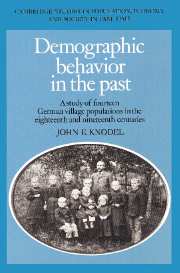 Demographic Behavior in the Past
Demographic Behavior in the Past Book contents
- Frontmatter
- Contents
- List of tables
- List of figures
- Acknowledgements
- PART I INTRODUCTION
- PART II MORTALITY
- PART III FAMILY FORMATION
- 6 Marriage
- 7 Marital dissolution and remarriage
- 8 Illegitimacy
- 9 Bridal pregnancy and prenuptial births
- PART IV MARITAL REPRODUCTION
- PART V INTERRELATIONSHIPS IN DEMOGRAPHIC BEHAVIOR
- PART VI CONCLUSION
- Appendices
- Bibliography
- Index
9 - Bridal pregnancy and prenuptial births
Published online by Cambridge University Press: 04 August 2010
- Frontmatter
- Contents
- List of tables
- List of figures
- Acknowledgements
- PART I INTRODUCTION
- PART II MORTALITY
- PART III FAMILY FORMATION
- 6 Marriage
- 7 Marital dissolution and remarriage
- 8 Illegitimacy
- 9 Bridal pregnancy and prenuptial births
- PART IV MARITAL REPRODUCTION
- PART V INTERRELATIONSHIPS IN DEMOGRAPHIC BEHAVIOR
- PART VI CONCLUSION
- Appendices
- Bibliography
- Index
Summary
Much of the premarital sexual activity in German villages in the past occurred among couples who subsequently married. This is apparent not only from the statistics on prenuptial births already presented in the previous chapter but even more so from the statistics on births that, although born after a couple married, were clearly conceived prior to the wedding date. This chapter focuses on the outcome of such premarital sexual activity, examining more closely the phenomenon of prenuptial births and exploring in detail the phenomenon of bridal pregnancy. Before proceeding to the analysis of these phenomena, however, a brief discussion about several issues relevant to the measurement of bridal pregnancy is in order.
Measuring bridal pregnancy
Fewer problems are involved in the measurement of bridal pregnancy than is the case for illegitimacy and its division into legitimized and non-legitimized births, as discussed in the previous chapter. In the present study, a woman is considered to have been pregnant at marriage if she gave birth by the start of the eighth elapsed month following the wedding date. While normal variance in the biological period of gestation will result in some women being misclassified with respect to bridal pregnancy, the margin of error should be minor. The net result is probably a slight underestimation of the proportion pregnant at marriage since use of an eight-month interval errs on the conservative side, excluding more births that were actually prenuptially conceived than falsely including births postnuptially conceived.
- Type
- Chapter
- Information
- Demographic Behavior in the PastA Study of Fourteen German Village Populations in the Eighteenth and Nineteenth Centuries, pp. 209 - 244Publisher: Cambridge University PressPrint publication year: 1988
